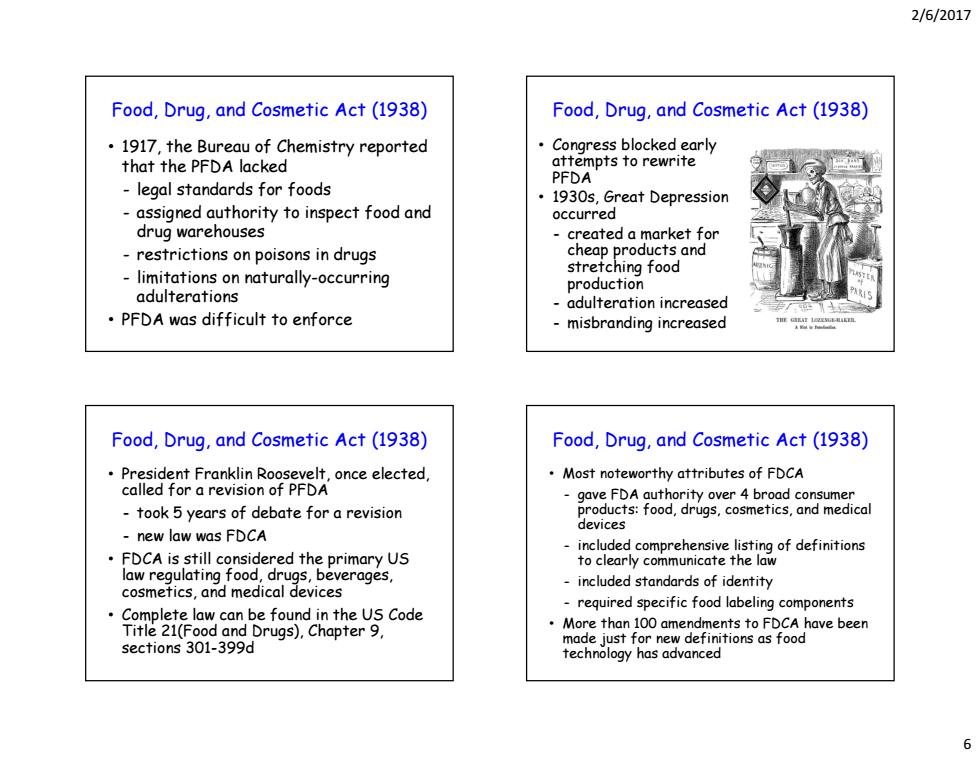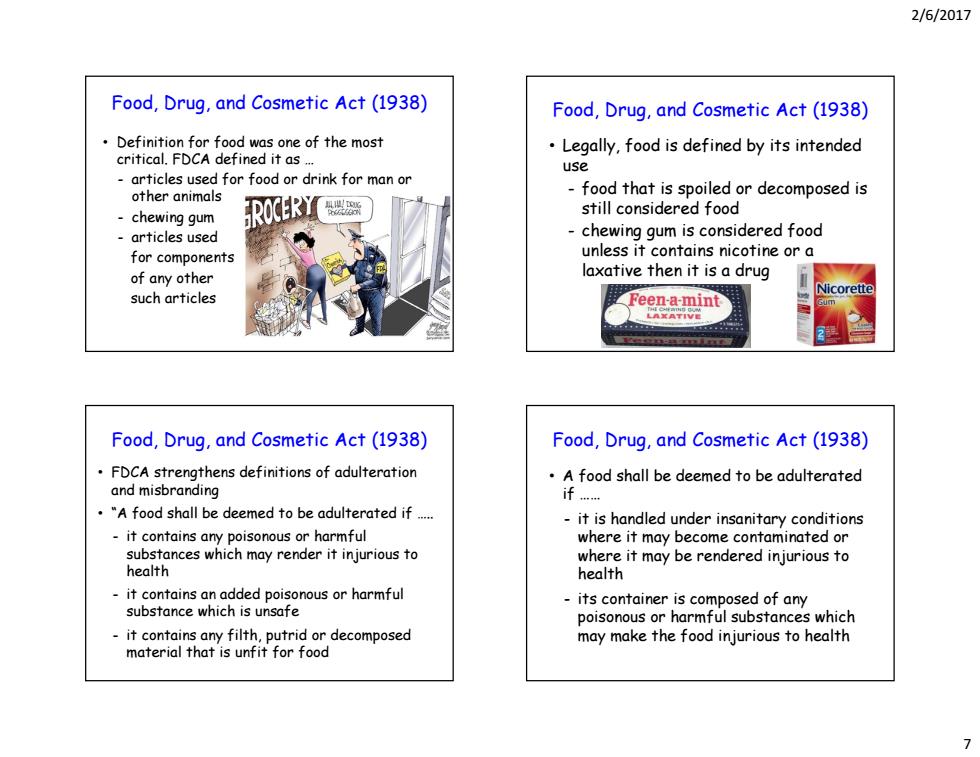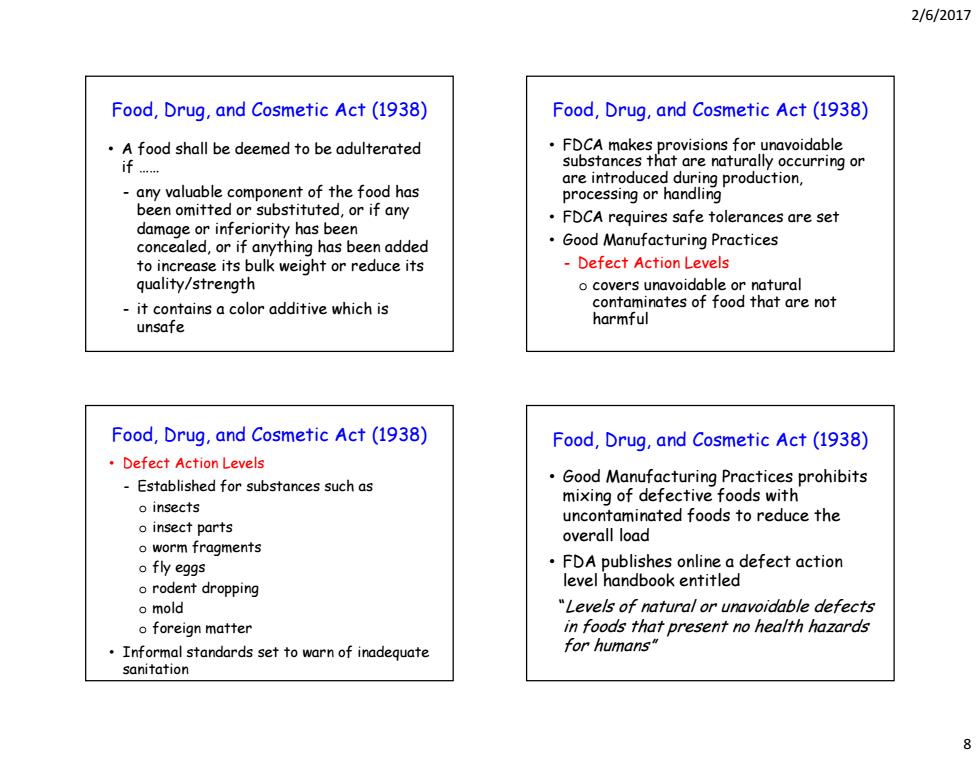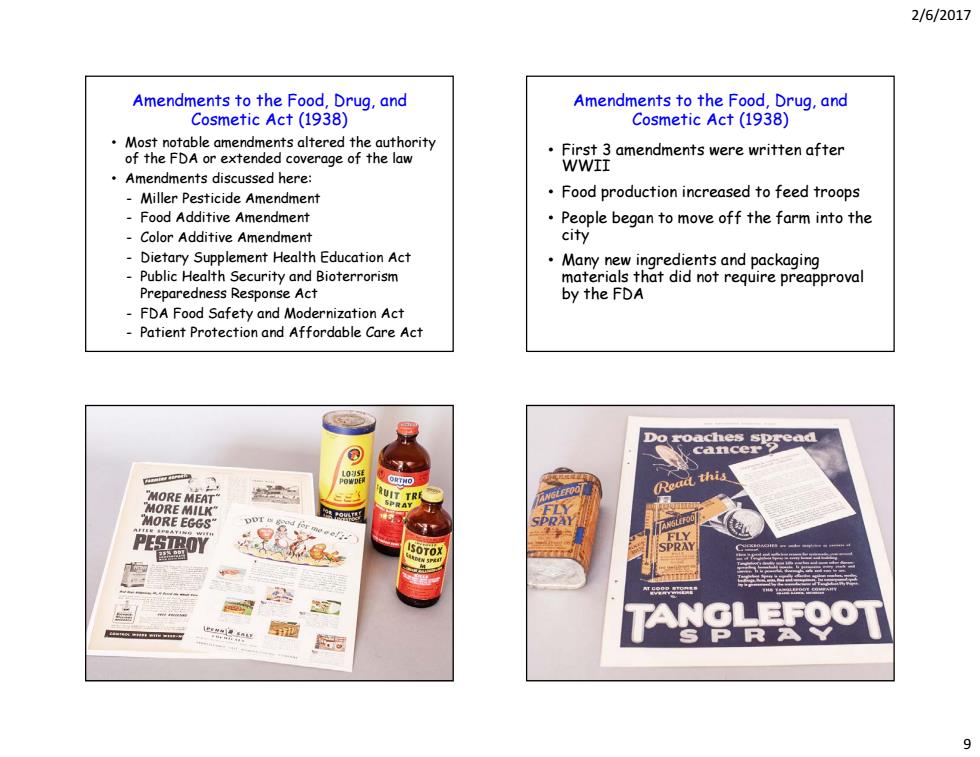
2/6/2017 Food,Drug,and Cosmetic Act(1938) Food,Drug,and Cosmetic Act(1938) 1917,the Bureau of Chemistry reported Congress blocked early that the PFDA lacked attempts to rewrite PFDA legal standards for foods 1930s,Great Depression assigned authority to inspect food and occurred drug warehouses created a market for -restrictions on poisons in drugs cheap products and stretching food limitations on naturally-occurring production adulterations -adulteration increased PFDA was difficult to enforce misbranding increased Food,Drug,and Cosmetic Act(1938) Food,Drug,and Cosmetic Act(1938) President Franklin Roosevelt,once elected, Most noteworthy attributes of FDCA called for a revision of PFDA gave FDA authority over 4 broad consumer -took 5 years of debate for a revision odus:food,drugs,cosmetics,and medical new law was FDCA included comprehensive listing of definitions FDCA is still considered the primary US to clearly communicate the law law regulating food,drugs,beverages, -included standards of identity cosmetics,and medical devices -required specific food labeling components Complete law can be found in the US Code Title 21(Food and Drugs),Chapter 9, More than 100 amendments to FDCA have been made just for new definitions as food sections 301-399d technology has advanced 6
2/6/2017 6 Food, Drug, and Cosmetic Act (1938) • 1917, the Bureau of Chemistry reported that the PFDA lacked - legal standards for foods - assigned authority to inspect food and drug warehouses - restrictions on poisons in drugs - limitations on naturally-occurring adulterations • PFDA was difficult to enforce Food, Drug, and Cosmetic Act (1938) • Congress blocked early attempts to rewrite PFDA • 1930s, Great Depression occurred - created a market for cheap products and stretching food production - adulteration increased - misbranding increased Food, Drug, and Cosmetic Act (1938) • President Franklin Roosevelt, once elected, called for a revision of PFDA - took 5 years of debate for a revision - new law was FDCA • FDCA is still considered the primary US law regulating food, drugs, beverages, cosmetics, and medical devices • Complete law can be found in the US Code Title 21(Food and Drugs), Chapter 9, sections 301-399d Food, Drug, and Cosmetic Act (1938) • Most noteworthy attributes of FDCA - gave FDA authority over 4 broad consumer products: food, drugs, cosmetics, and medical devices - included comprehensive listing of definitions to clearly communicate the law - included standards of identity - required specific food labeling components • More than 100 amendments to FDCA have been made just for new definitions as food technology has advanced

2/6/2017 Food,Drug,and Cosmetic Act(1938) Food,Drug,and Cosmetic Act(1938) Definition for food was one of the most Legally,food is defined by its intended critical.FDCA defined it as use articles used for food or drink for man or other animals food that is spoiled or decomposed is -chewing gum still considered food articles used chewing gum is considered food for components unless it contains nicotine or a of any other laxative then it is a drug Nicorette such articles Feen-a-mint Food,Drug,and Cosmetic Act(1938) Food,Drug,and Cosmetic Act(1938) FDCA strengthens definitions of adulteration A food shall be deemed to be adulterated and misbranding if… ."A food shall be deemed to be adulterated if... -it is handled under insanitary conditions it contains any poisonous or harmful where it may become contaminated or substances which may render it injurious to where it may be rendered injurious to health health it contains an added poisonous or harmful its container is composed of any substance which is unsafe poisonous or harmful substances which it contains any filth,putrid or decomposed may make the food injurious to health material that is unfit for food 1
2/6/2017 7 Food, Drug, and Cosmetic Act (1938) • Definition for food was one of the most critical. FDCA defined it as … - articles used for food or drink for man or other animals - chewing gum - articles used for components of any other such articles Food, Drug, and Cosmetic Act (1938) • Legally, food is defined by its intended use - food that is spoiled or decomposed is still considered food - chewing gum is considered food unless it contains nicotine or a laxative then it is a drug Food, Drug, and Cosmetic Act (1938) • FDCA strengthens definitions of adulteration and misbranding • “A food shall be deemed to be adulterated if ….. - it contains any poisonous or harmful substances which may render it injurious to health - it contains an added poisonous or harmful substance which is unsafe - it contains any filth, putrid or decomposed material that is unfit for food Food, Drug, and Cosmetic Act (1938) • A food shall be deemed to be adulterated if …… - it is handled under insanitary conditions where it may become contaminated or where it may be rendered injurious to health - its container is composed of any poisonous or harmful substances which may make the food injurious to health

2/6/2017 Food,Drug,and Cosmetic Act(1938) Food,Drug,and Cosmetic Act(1938) A food shall be deemed to be adulterated FDCA makes provisions for unavoidable if… substances that are naturally occurring or any valuable component of the food has are introduced during production, processing or handling been omitted or substituted,or if any FDCA requires safe tolerances are set damage or inferiority has been concealed,or if anything has been added Good Manufacturing Practices to increase its bulk weight or reduce its -Defect Action Levels quality/strength o covers unavoidable or natural it contains a color additive which is contaminates of food that are not unsafe harmful Food,Drug,and Cosmetic Act(1938) Food,Drug,and Cosmetic Act(1938) ·Defect Action Levels Established for substances such as Good Manufacturing Practices prohibits mixing of defective foods with o insects uncontaminated foods to reduce the o insect parts overall load o worm fragments o fly eggs FDA publishes online a defect action o rodent dropping level handbook entitled o mold "Levels of natural or unavoidable defects o foreign matter in foods that present no health hazards Informal standards set to warn of inadequate for humans" sanitation
2/6/2017 8 Food, Drug, and Cosmetic Act (1938) • A food shall be deemed to be adulterated if …… - any valuable component of the food has been omitted or substituted, or if any damage or inferiority has been concealed, or if anything has been added to increase its bulk weight or reduce its quality/strength - it contains a color additive which is unsafe Food, Drug, and Cosmetic Act (1938) • FDCA makes provisions for unavoidable substances that are naturally occurring or are introduced during production, processing or handling • FDCA requires safe tolerances are set • Good Manufacturing Practices - Defect Action Levels o covers unavoidable or natural contaminates of food that are not harmful Food, Drug, and Cosmetic Act (1938) • Defect Action Levels - Established for substances such as o insects o insect parts o worm fragments o fly eggs o rodent dropping o mold o foreign matter • Informal standards set to warn of inadequate sanitation Food, Drug, and Cosmetic Act (1938) • Good Manufacturing Practices prohibits mixing of defective foods with uncontaminated foods to reduce the overall load • FDA publishes online a defect action level handbook entitled “Levels of natural or unavoidable defects in foods that present no health hazards for humans

2/6/2017 Amendments to the Food,Drug,and Amendments to the Food,Drug,and Cosmetic Act (1938) Cosmetic Act (1938) Most notable amendments altered the authority of the FDA or extended coverage of the law First 3 amendments were written after WWII Amendments discussed here: Miller Pesticide Amendment Food production increased to feed troops Food Additive Amendment People began to move off the farm into the Color Additive Amendment city Dietary Supplement Health Education Act Many new ingredients and packaging -Public Health Security and Bioterrorism materials that did not require preapproval Preparedness Response Act by the FDA FDA Food Safety and Modernization Act Patient Protection and Affordable Care Act aches spread MORE MEAT MORE MILK MORE EGGS PESTROY 通 司 默T 9
2/6/2017 9 Amendments to the Food, Drug, and Cosmetic Act (1938) • Most notable amendments altered the authority of the FDA or extended coverage of the law • Amendments discussed here: - Miller Pesticide Amendment - Food Additive Amendment - Color Additive Amendment - Dietary Supplement Health Education Act - Public Health Security and Bioterrorism Preparedness Response Act - FDA Food Safety and Modernization Act - Patient Protection and Affordable Care Act Amendments to the Food, Drug, and Cosmetic Act (1938) • First 3 amendments were written after WWII • Food production increased to feed troops • People began to move off the farm into the city • Many new ingredients and packaging materials that did not require preapproval by the FDA